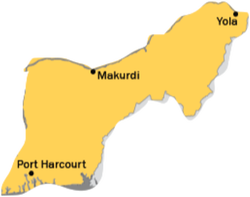Eastern Nigeria

Physical Features
Eastern Nigeria sits on the Gulf on Guinea, and beside the Bight of Biafra. In Eastern Nigeria, there are the Niger River, and the Niger Delta. The Niger Delta is the largest wetland, and has the largest oil deposits. Swampland lines the coast of eastern nigeria.
Ethnic Groups
Igbo is the largest ethnic group in Eastern Nigeria. The Igbo settled there thousands of years ago. The Igbo lived in villages, each ruled by a council of elders. Each village spoke different dialects of the Igbo language. The Igbo worked with British missionaries and officials. Once Nigeria gained independence, other ethnic groups treated the Igbo terribly. In 1967, the Igbo wanted to break away from Nigeria, to form thier own country called Biafra. In the war fought for it, hundreds of thousands were killed. Nigeria was united again in 1970 when the war was finally over.
Culture
Eastern Nigerians that live in the city live in mud brick houses with metal roofs. People who live in more swampy areas live in houses on stilts. During the rainy season, people have to paddle canoes and climb ladders to get inside. Eastern Nigerians dress in colorful cloth. During ceremonies, masked dancing is common. The masks are homemade from wood or leather and decorated with teeth, hair, fur, and more. These masks are made secretly and are hidden until they are worn at ceremonies. This is so that they remain mysterious and important.
Economy
The main economic activity in Eastern Nigeria used to be farming, but now it is oil. In fact, most of Nigeria's wealth comes from exporting oil to other countries. Foreign oil companies run Nigeria's oil industry, and they used to send in foreign workers to do the job. This was taking work away from Nigerians, so the government put a stop to this. Education has changed the lives of the people of Eastern Nigeria. They are now able to go to universities and become doctors, lawyers, and teachers.
Eastern Nigeria sits on the Gulf on Guinea, and beside the Bight of Biafra. In Eastern Nigeria, there are the Niger River, and the Niger Delta. The Niger Delta is the largest wetland, and has the largest oil deposits. Swampland lines the coast of eastern nigeria.
Ethnic Groups
Igbo is the largest ethnic group in Eastern Nigeria. The Igbo settled there thousands of years ago. The Igbo lived in villages, each ruled by a council of elders. Each village spoke different dialects of the Igbo language. The Igbo worked with British missionaries and officials. Once Nigeria gained independence, other ethnic groups treated the Igbo terribly. In 1967, the Igbo wanted to break away from Nigeria, to form thier own country called Biafra. In the war fought for it, hundreds of thousands were killed. Nigeria was united again in 1970 when the war was finally over.
Culture
Eastern Nigerians that live in the city live in mud brick houses with metal roofs. People who live in more swampy areas live in houses on stilts. During the rainy season, people have to paddle canoes and climb ladders to get inside. Eastern Nigerians dress in colorful cloth. During ceremonies, masked dancing is common. The masks are homemade from wood or leather and decorated with teeth, hair, fur, and more. These masks are made secretly and are hidden until they are worn at ceremonies. This is so that they remain mysterious and important.
Economy
The main economic activity in Eastern Nigeria used to be farming, but now it is oil. In fact, most of Nigeria's wealth comes from exporting oil to other countries. Foreign oil companies run Nigeria's oil industry, and they used to send in foreign workers to do the job. This was taking work away from Nigerians, so the government put a stop to this. Education has changed the lives of the people of Eastern Nigeria. They are now able to go to universities and become doctors, lawyers, and teachers.
